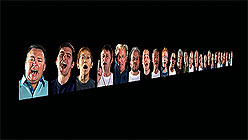Everybody remembers his or her Beatles indoctrination. Mine was at summer camp, when our counselors popped their 20 Greatest Hits cassette into the boom box and taught us the lyrics to Love Me Do so we could serenade the boys’ cabin. I came home from camp begging for that tape and proceeded to memorize it, singing the entire album aloud, over and over, while simultaneously spending the rest of my summer trying to beat Super Mario 3 on Nintendo. Candice Breitz preys on such collective memories of popular culture, using familiar characters to create her video mash-ups, two of which are now on view at SFMOMA.
For her installation titled Working Class Hero (A Portrait of John Lennon) Breitz enlisted a “diverse” group of 25 diehard Lennon fans to sing his first post-Beatles album from beginning to end. Wearing flesh-toned headphones, it appears each participant sang alone. As most are not exactly professional singers, and Plastic Ono Band was not exactly a melodic sing-a-long record, you can imagine their tributes sound less than perfect. But when the videos are rolled in unison, the hodge-podge chorus becomes quite endearing.
At first inspired to count heads and analyze the fans’ demographics, I wasn’t sold right away. The group of mostly Caucasian men who you wouldn’t jump at the chance to date made up the choir, and I spent the first ten minutes of the nearly 40-minute-long piece wondering why this homogeneous selection of people was labeled “diverse” in the museum’s wall text, and what exactly Breitz’s criteria for performers was. A February 2009 ArtNews article about Breitz’s similar installation, Legend (A Portrait of Bob Marley), vaguely states that “people who best described how their lives had been affected by” the musicians were chosen.

Candice Breitz, Working Class Hero (A Portrait of John Lennon), 2006
Once I forced my analytical-critical mind to shut up for a minute, I began to soak up the experience in full. Singing out loud alone is one of the rawest and most private moments a person can have, especially if he or she is not a terrific singer. Watching these people, pictured just slightly larger than life on vertical monitors with unforgiving lights causing their foreheads to glisten as they sing their hearts out, became touching. Cracking open windows to their souls, they precariously carried the tunes with no audible musical backup, belting lyrics like “Mama don’t go/Daddy come home” with a passion seemingly equivalent to John Lennon’s.



